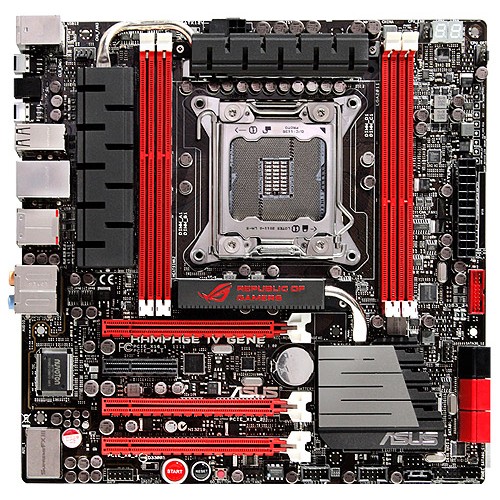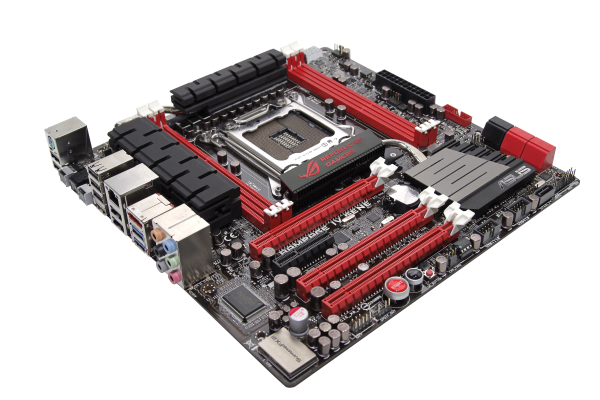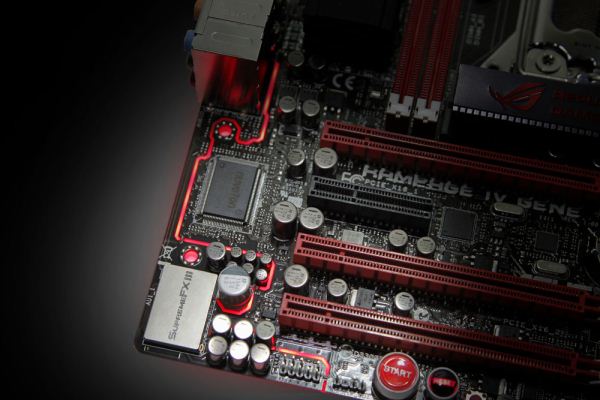ASUS Republic of Gamers and X79 ROG Review – Rampage IV Gene, Formula and Extreme
by Ian Cutress on August 3, 2012 1:00 PM EST- Posted in
- Motherboards
- Asus
- X79
- ROG
Rampage IV Gene Overview
When considering the Rampage IV Gene, it is hard to look past the fact that it is a micro ATX product. Typically for such a price, one would expect a full sized ATX product with all the bells and whistles. But given that we are dealing with the 2011 chipset, almost everything costs a pretty penny anyway, but I also discussed with ASUS their action on the Gene.
Despite the fact that it is a smaller board, it covers several primary markets – power users, small(er) form factor gamers and overclockers. ASUS were keen to stress to me to see the Gene not as a restricted regular ROG board but as the entry level ROG board. From that perspective then it comes to light that yes indeed, the Gene does satisfy a lot of the main criteria for gamers – dual GPU in slots 1 and 3 or 1 and 4 with a full length PCIe card in the middle slot if required. Compared to the Extreme, it also includes an enhanced audio solution.
With the Gene being mATX, we obviously have some restrictions – only four memory slots. But this is given that most gamers will not require more than 16GB of memory (given a typical 4x4 GB setup - the Gene does support 4x8GB). Despite this, we still get more SATA 6 Gbps ports, fully controllable fan headers, enhanced heatsink and heatpipe design for heat transferal and USB 3.0 at the back on top of all the ASUS ROG enabled software (listed later in the review).
Performance wise, all the ROG boards have an advantage over the other X79 boards we have tested in terms of CPU performance at stock, due to ASUS’ policy of applying the maximum turbo mode during any load. This means that with a normal X79 board, the 3960X CPU should run at 3.9 GHz during 1 and 2 threaded load, going down to 3.6 GHz at full load. The ASUS policy is ‘MultiCore Enhancement’, meaning users will get 3.9 GHz whatever the load, giving a 300 MHz improvement at full load.
Thus for the most part, the Gene does perform better than the other X79 boards we have tested. Against the other two ROG boards it does seem to be behind the Extreme and the Formula, but by no means is it a slouch. It performs well under pressure, and is indeed a good entry board for those under the ROG bandwagon. It is also worth mentioning that the Gene comes with a competitive 3-year warranty and qualifies in North America for ASUS Premium Service.
Visual Inspection

The ROG theme is relatively straight forward – red and black, with a little grey and silver if you have to. One thing which may immediately jump out is the size of the heatsinks. Covering the power delivery is a fairly substantial pair of heatsinks connected with a heatpipe. Just to the close proximity of everything in the socket area (note that ASUS always has extra chips to deal with power and overclocking et al. on board), users have the default Intel specifications to deal with on space. Some form of all-in-one liquid cooling system would be ideal here.
For fan headers, users will find one 4-pin to the top left of the socket, two 4-pin headers to the top right of the socket (one to the left of the two-digit debug, one to the right) and another just beside the 24-pin ATX power connector. The final header on board is 4-pin and found on the bottom of the board between the Reset button and the USB header.
Down the right hand side of the board, users will find that two-digit debug previously mentioned (useful for enthusiasts determining errors), the 24-pin ATX power connector, a USB 3.0 front panel header (ASMedia), and the SATA ports. Typically on X79 we have four SATA 3 Gbps and two SATA 6 Gbps from the chipset. Here on the Gene, ASUS are using two SATA 3 Gbps from the chipset (black), two SATA 6 Gbps from chipset (red) and two more SATA 6 Gbps from a controller (red, ASMedia). The other two 3 Gbps ports are found such that one is facing out of the board at the bottom (gray), and one provides the eSATA port on the IO panel.
Along the bottom of the board are our standard array of headers – front panel audio, USB, and also the BIOS chip. The Gene also includes power and reset buttons, useful for reviewers and overclockers. Also onboard is a Go Button, which allows overclockers to apply a set of values selected in the BIOS during system operation. Using such a button could be a help or a hindrance, based on the severity of the overclock and system stability, but it is still a feature ASUS have included.
Special notes should be said about the audio solution. ASUS have dug into their pockets to provide the Gene with a better-than-Realtek solution, in the SupremeFX III. This section of the board has two main features which set it apart from a lot of other standard boards on the market – the audio signaling has its own PCB layer for traces, helping reduce interference. The section is also shielded from interference through the board partitioning, as shown below:
The SupremeFX III solution is rated as having a 110dB SNR, compared to the majority of audio products today offering 108dB SNR or less (typically 92-98dB). As will be mentioned later in the review, this comes about due to the design and a 1500µF capacitor.
The PCIe configuration is designed to help those with more than one PCIe device – GPUs can be placed in any slot and still display video, giving access to other full length PCIe channels or the PCIe x1 slot as required. Ideal routing should allow GPUs in slots 1/3, or 1/4 if an additional card (RAID or PCIe SSD) is required.

Back panel mixes some old and the new – from left to right, we have a combination PS/2 port, two USB 2.0 (black), USB BIOS Flashback button (which I have tested and can confirm it works great), optical SPDIF output, ROG Connect, four USB 2.0 (black, white at bottom for USB Flashback/ROG Connect), Intel GbE, two more USB 2.0 (black), one eSATA 3 Gbps (red), two USB 3.0 (ASMedia, blue), and standard audio jacks.


















34 Comments
View All Comments
Flunk - Friday, August 3, 2012 - link
Ivy Bridge is more of a notebook oriented update anyway. The much better integrated graphics don't really matter to us anyway.G-Man - Friday, August 3, 2012 - link
Fantastic article, Ian! You must have been working on this for a long time. Thanks for a great read.B - Friday, August 3, 2012 - link
Ian -I would like to point out that under that nice metal Creative X-FI chip badge is, in fact, a Realtek processor. The Soundblaster piece of this is a merely a software implementation. I have this motherboard and was quite disappointed to discover this.
Thanks for great and thorough article.
just4U - Friday, August 3, 2012 - link
Indeed.. It's a little bit of a letdown. It will be nice if they are pushed away from the realtek chip now that Gigabyte is into similiar type boards which utilize the Creative recon chips.primonatron - Friday, August 3, 2012 - link
The article should be edited to specificy that it's only a Relatek chip, not a Creative one, at this point it's just blatent false advertising.When doing the review, did Anandtech actually do a Windows 7 install on it themselves?
They would have known if they did.
IanCutress - Friday, August 3, 2012 - link
As per my comment above, it states this in the tenth page. And yes, I do install Windows 7 fresh on every board I test. It would be crazy not to. I see the whole install procedure at least twice a week, as well as installing each vendors drivers and software. The ASUS install procedure for drivers is all one-button automatic, no user input required, no giant screens flashing up on the screen to ask to confirm this that or the other.Ian
primonatron - Friday, August 3, 2012 - link
I would not put " ASUS have dug into their pockets to provide the Gene with a better-than-Realtek solution, in the SupremeFX III" since it IS a Realtek solution.IanCutress - Friday, August 3, 2012 - link
Written in page 10:"In our SupremeFX III, we essentially get a Realtek codec (presumed ALC898), but by being stage III this chip is isolated from the rest of the board, has a separate EMI shield around the chip, its own PCB layer for audio tracing, a 1500 mF capacitor to reduce ripple, and gold plated audio jacks to minimize resistance. As a result, the SNR is increased to 110dB."
Ian
just4U - Saturday, August 4, 2012 - link
It also needs to be noted that soundchips getting decent software can be a fairly substantial bump.. atleast from my point of view. I seem to recall Creative nailing a company to the wall because they used software the emulated soundblaster stuff and they were reall popular 7 years back.just4U - Friday, August 3, 2012 - link
I've been using these for several years... and have always found that they offer more then most standard ATX boards in lesser and similiar price ranges. Your not paying the Big bucks but you have your foot in the door.. (as it were.. lol)They can be problematic at times mind you.. I've found that quality control can be a bit of an issue with dead boards coming in now and again. We are dealing with sensitive electronics mind you so that happens.
I must say they do have some competition now with Gigabyte's M3s sniper boards, that do utilize a true recon3d sound chip from Creative (as opposed to a realtek chip with software emulation). My hope is that it pushes Asus towards a similiar move as the sound is a key feature for these baby boards.
Personally I think the Gene series deserves your silver award. While high end boards can be had from all makers getting a good solid feature rich gaming MATX board is not the norm and they are almost allways a pleasure to work with.
Great review Ian.